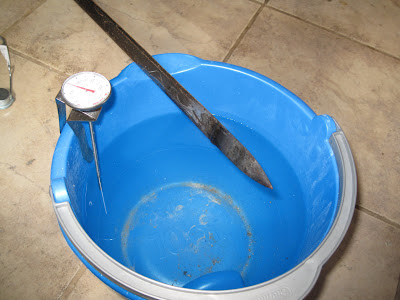
The bucket holds 5 G and is more or less 4G full. The blowtorch is a standard propane torch. The sword is made of steel, I believe, is unsharpened, and is something I picked up at a garage sale. Attached to the bucket is an oven thermometer that turned out to be useless; I also had a digital thermometer. The fire extinguisher was fortunately unnecessary.
Part 1: Heating the flat of the blade with the blowtorch.
I rested the blowtorch on the ground and put the wide part of the blade, just behind the tip, in the flame. I held on to the blade near the hilt, ready to stop if I felt it getting warm at all, but the temperature of the blade in my hand never changed. After about 2 minutes, the blade started to glow dull red where it was being heated. I quenched it in the bucket, raising the water's temperature from 61.5 F to 62.0 F. The water boiled around the blade for a second, but it was quickly cooled down to water temperature.
Part 2: Heating the tip in with the blowtorch
For my second attempt, I tried heating just the tip, to see how quickly I could heat it. It was cherry-red after about 1.5 minutes, as you can almost see in the pictures below.
When I quenched it, it barely sizzled, significantly less boiling than the first attempt.
Part 3: Heating the tip on the stovetop
For my third attempt, I placed about 3 inches of the blade in the flame from the burner of my gas stove. The tip glowed cherry-red after about 2.5 minutes, although it faded quickly when I shifted it slightly. After 4 minutes, I took it off the stove and quenched it. The boiling was much more dramatic, as the blade had obviously stored quite a bit more heat than in the previous two attempts. I believe this is because much more of the blade was directly in the fire than when I used the blowtorch, and it stayed there much longer. After I quenched it, I ran water down the blade to check its temperature, and it was hot enough to quickly make the water steam visibly as far as 6" above the tip.
Conclusions and future investigations
- A blowtorch heats the steel more quickly than the stove, but the stove is able to transfer more heat energy to the blade, most likely because of the size of the heated area.
- It's safe to handle the end of the blade with my bare hands, although maneuvering the hot, long blade around can be a little tricky, and I'd be worried about trying to get it into a tall glass without hitting the side or spilling the drink.
- Steel heated for short periods of time raised about 4G of water 0.5 deg F (although I didn't control for the heating due to the warmer room air). The numbers are very rough, but the same amount of energy raises 4oz of water 64 deg F, which is in the ballpark for making a warm drink.
- I'd like to get a piece of rebar or other iron or steel rod, which would be thicker in cross section. It should hold more heat, although be proportionally slower to heat up.
- I'd also like to pick up an infrared thermometer, to take readings of how hot the steel is.
- I also need to investigate holding the steel so that the long axis aligns with the flame of the blowtorch, so more of the steel is exposed to the flame.






Cool. Experiments! I wish you luck in this process...
ReplyDelete